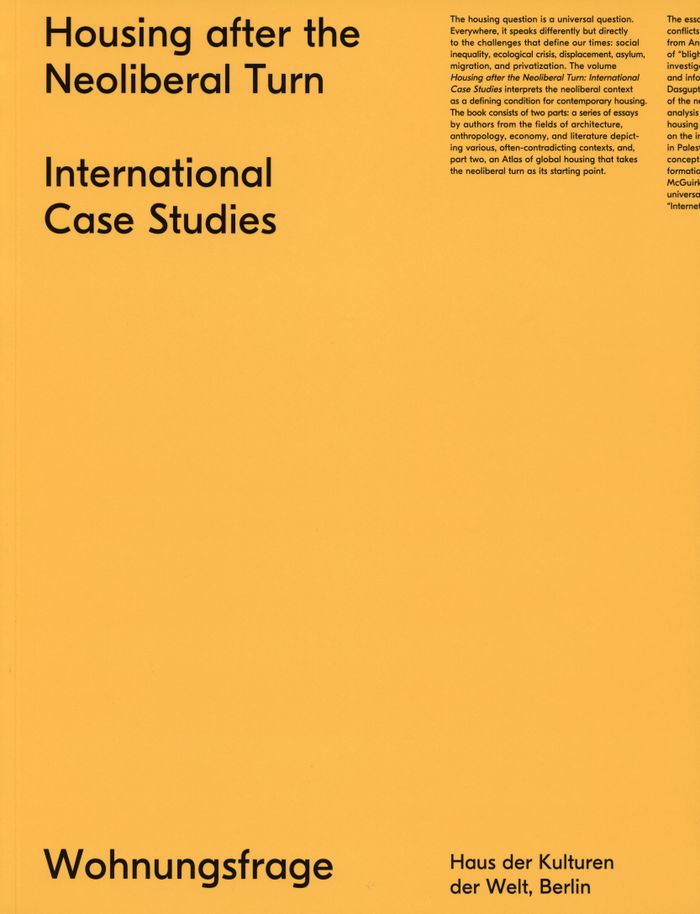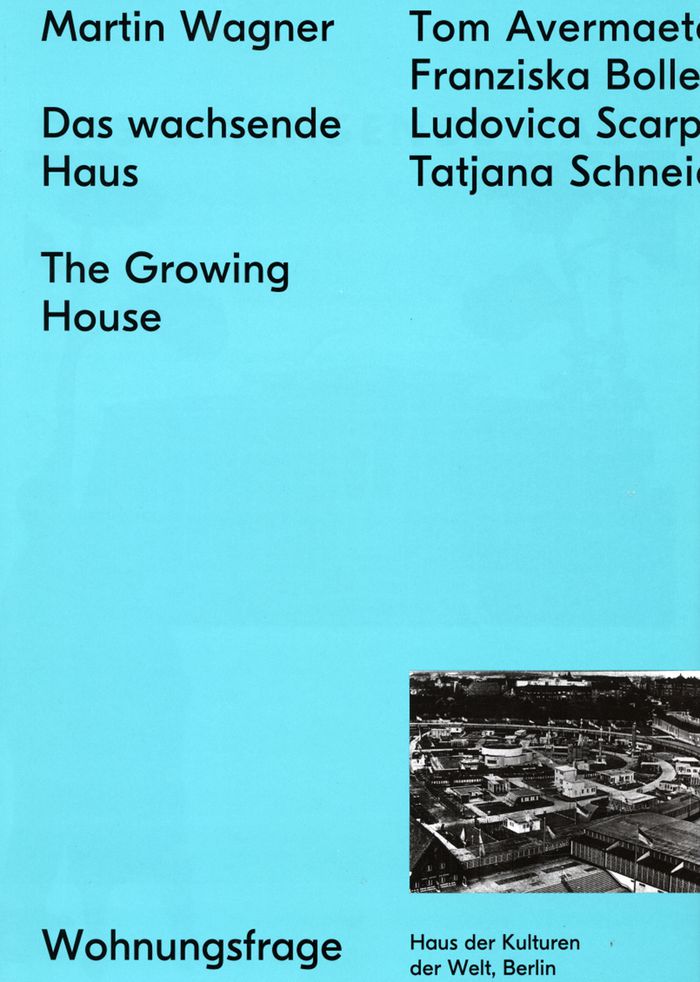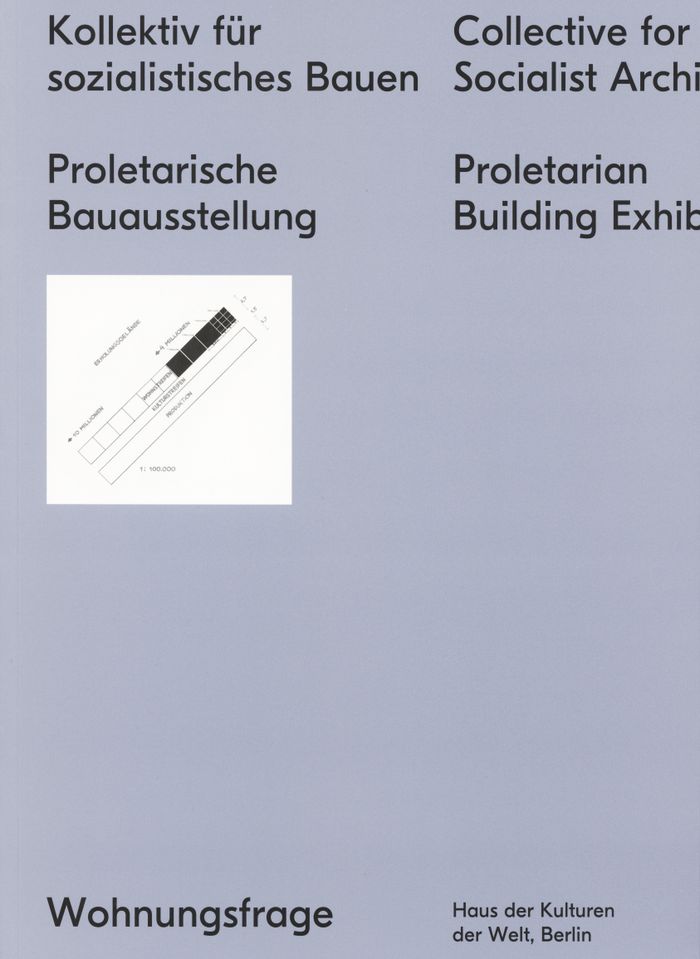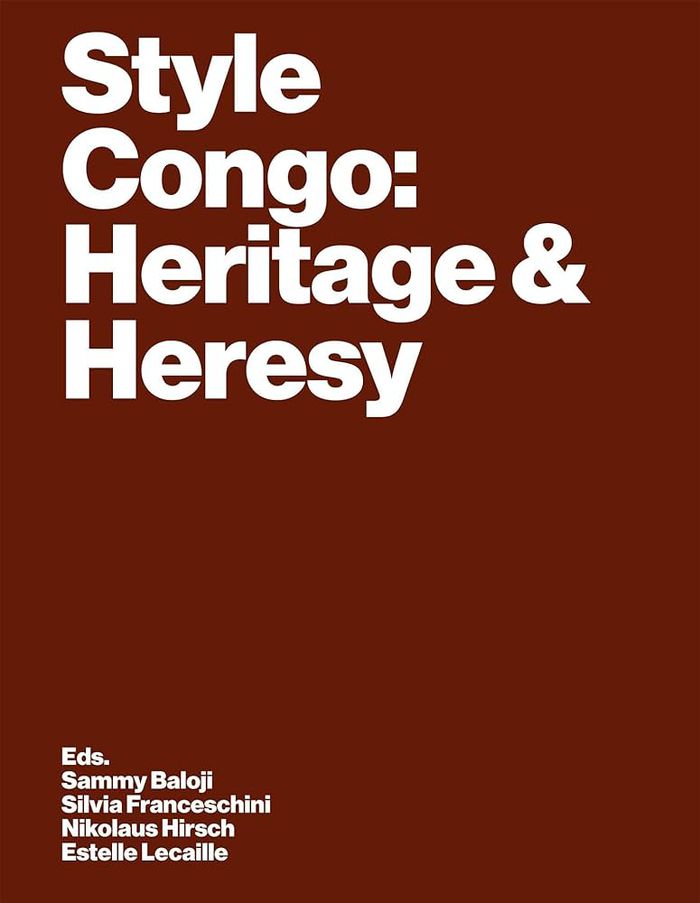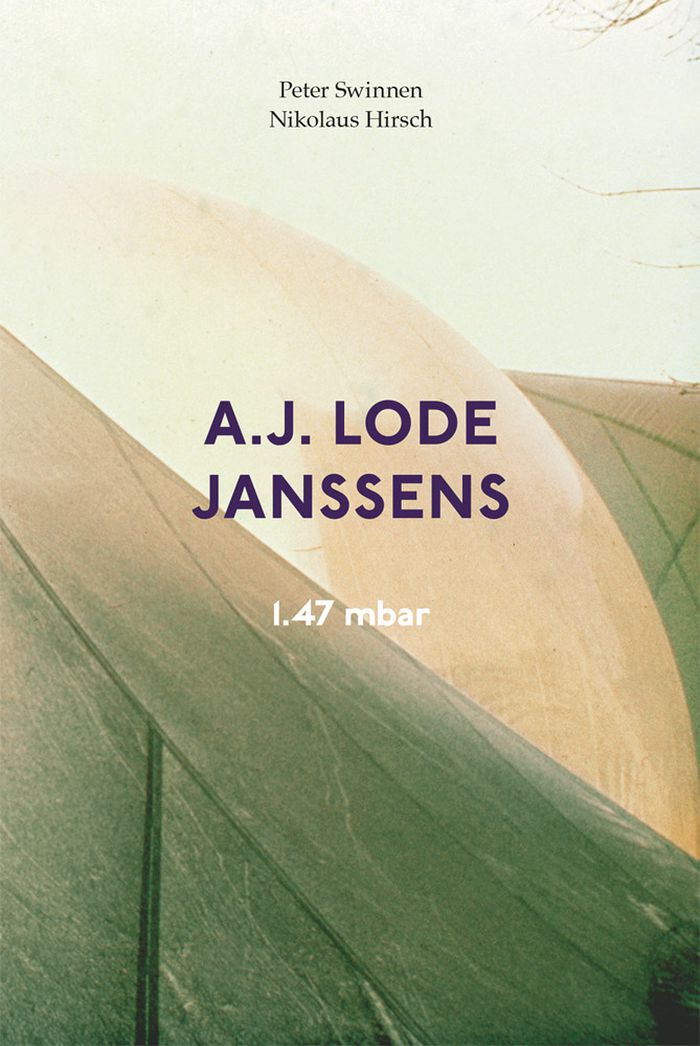$36.00
(available to order)
Summary:
Housing speaks directly to the challenges that define our times: social inequality, ecological crisis, displacement, asylum, migration and privatization. Framing the neo-liberal context as a defining condition of contemporary housing, International Case Studies consists of two parts: a series of essays by authors from architecture, anthropology, economy and literature,(...)
Collective Housing
July 2016
Housing after the neoliberal turn: international case studies
Actions:
Price:
$36.00
(available to order)
Summary:
Housing speaks directly to the challenges that define our times: social inequality, ecological crisis, displacement, asylum, migration and privatization. Framing the neo-liberal context as a defining condition of contemporary housing, International Case Studies consists of two parts: a series of essays by authors from architecture, anthropology, economy and literature, and an “atlas” of global housing that takes neo-liberalism as its starting point. The essays shed light on the challenges and conflicts of contemporary housing production from Andrew Herscher’s research on the politics of “blight” in Detroit to Justin McGuirk’s text on domesticity as data and universal housing questions eclipse by the “Internet of Things.” Conceptualized and compiled by architectural critic-historian Anne Kockelkorn and Columbia professor Reinhold Martin, the illustrated “atlas” presents 33 housing examples rarely seen together and invites readers to think of housing as an unstable constellation evolving within the power relations of territorial processes.
Collective Housing
Gwangju Folly II
$55.00
(available to order)
Summary:
Throughout history, follies have been used as a provocation, a frivolous diversion or strategic place of madness and satire freed from the constraints of societal norms. This volume documents a series of eight newly commissioned follies forging links between everyday uses and political practice.
April 2014
Gwangju Folly II
Actions:
Price:
$55.00
(available to order)
Summary:
Throughout history, follies have been used as a provocation, a frivolous diversion or strategic place of madness and satire freed from the constraints of societal norms. This volume documents a series of eight newly commissioned follies forging links between everyday uses and political practice.
$60.00
(available to order)
Summary:
In 1931, in response to the Great Depression and subsequent collapse of the building industry, Martin Wagner (1885–1957), then head of planning for Berlin, formulated plans for an adaptable micro-house called “the growing house.” Working with Egon Eiermann, Walter Gropius, Ludwig Hilberseimer, Erich Mendelssohn, Hans Poelzig and Hans Scharoun, the growing house was(...)
Collective Housing
June 2016
Martin Wagner: the Growing House / Das wachsende Haus
Actions:
Price:
$60.00
(available to order)
Summary:
In 1931, in response to the Great Depression and subsequent collapse of the building industry, Martin Wagner (1885–1957), then head of planning for Berlin, formulated plans for an adaptable micro-house called “the growing house.” Working with Egon Eiermann, Walter Gropius, Ludwig Hilberseimer, Erich Mendelssohn, Hans Poelzig and Hans Scharoun, the growing house was designed to be modified with the changing socioeconomic circumstances of its inhabitants, providing only what was necessary and expedient. Wagner’s coruscating foreword outlining his proposals for a new social, technical and economic fabric shifting the dwelling to the center of the world is published here for the first time. Historical and contemporary black-and-white and color illustrations, drawings, plans and photographs of the prototype are accompanied by commentary from Franziska Bollerey, Ludovica Scarpa, Tom Avermaete and Tatjana Schneider, demonstrating that the growing house is as relevant today as it was 100 years ago.
Collective Housing
$44.00
(available in store)
Summary:
In an empty factory unit tucked away in Berlin’s Köpenicker Strasse, The Proletarian Building Exhibition was mounted with the humblest of resources in 1931. It marked the first action by a group of revolutionary architects, builders, and students forming the Kollektiv für sozialistisches Bauen under the architect Arthur Korn. Taking aim at modernist architects(...)
May 2016
Collective for a socialist architecture: proletarian building exhibition 1931
Actions:
Price:
$44.00
(available in store)
Summary:
In an empty factory unit tucked away in Berlin’s Köpenicker Strasse, The Proletarian Building Exhibition was mounted with the humblest of resources in 1931. It marked the first action by a group of revolutionary architects, builders, and students forming the Kollektiv für sozialistisches Bauen under the architect Arthur Korn. Taking aim at modernist architects participating in the German Building Exhibition and CIAM, they cast architecture as an instrument of power, questioned capitalist solutions to the housing question, and unveiled planning approaches imported from the then-Soviet Union. A full facsimile of the exhibition manifesto/catalog and exhibition panels is featured in addition to contributing essays by contemporary architects, writers and educators, and the Collectives’ Annual Report including a proposed work program and statement of intent. Historical photos are interspersed throughout providing a full reconstruction of this significant architectural and sociopolitical event.
$41.99
(available in store)
Summary:
The current epoch is one of accumulation: not only of capital but also of raw, often unruly material, from plastic in the ocean and carbon in the atmosphere to people, buildings, and cities. Alongside this material growth, image-making practices embedded within the fields of art and architecture have proven to be fertile, mobile, and capacious. Images of accumulation help(...)
Architectural Theory
April 2022
Accumulation: the art, architecture and media of climate change
Actions:
Price:
$41.99
(available in store)
Summary:
The current epoch is one of accumulation: not only of capital but also of raw, often unruly material, from plastic in the ocean and carbon in the atmosphere to people, buildings, and cities. Alongside this material growth, image-making practices embedded within the fields of art and architecture have proven to be fertile, mobile, and capacious. Images of accumulation help open up the climate to cultural inquiry and political mobilization and have formed a cultural infrastructure focused on the relationships between humans, other species, and their environments. The essays in ''Accumulation'' address this cultural infrastructure and the methodological challenges of its analysis. They offer a response to the relative invisibility of the climate now seen as material manifestations of social behavior. Contributors outline opportunities and ambitions of visual scholarship as a means to encounter the challenges emergent in the current moment: how can climate become visible, culturally and politically? Knowledge of climatic instability can change collective behavior and offer other trajectories, counteraccumulations that draw the present into a different, more livable, future.
Architectural Theory
$56.95
(available in store)
Summary:
''Style Congo: Heritage & heresy'' examines the politics of cultural representation and appropriation through contemporary artistic and architectural interventions, as well as historical materials primarily sourced from the CIVA collection in Brussels. Starting with the Art Nouveau movement and stemming from the exhibition of the same name, this book traces the portrayal(...)
September 2023
Style Congo: Heritage and heresy
Actions:
Price:
$56.95
(available in store)
Summary:
''Style Congo: Heritage & heresy'' examines the politics of cultural representation and appropriation through contemporary artistic and architectural interventions, as well as historical materials primarily sourced from the CIVA collection in Brussels. Starting with the Art Nouveau movement and stemming from the exhibition of the same name, this book traces the portrayal of the Congo in international and colonial exhibitions in Belgium, France, and the Congo between 1885 and 1958.
$41.50
(available to order)
Summary:
A.J. Lode Janssens is one of Belgium’s most idiosyncratic architects and a radical educator. He was cofounder of the experimental studio Atelier Alpha and the Sint-Lucas Werkgemeenschap, a workshop linking architectural education, practice and research, and operated in close collaboration with ILAUD, the International Laboratory of Architecture and Urban Design. This(...)
A. J. Lode Janssens: 1,47 mbar. Balloon Home
Actions:
Price:
$41.50
(available to order)
Summary:
A.J. Lode Janssens is one of Belgium’s most idiosyncratic architects and a radical educator. He was cofounder of the experimental studio Atelier Alpha and the Sint-Lucas Werkgemeenschap, a workshop linking architectural education, practice and research, and operated in close collaboration with ILAUD, the International Laboratory of Architecture and Urban Design. This publication presents The Balloon, an all-but-unknown temporary pneumatic home experiment, built in 1973 in Humbeek, where he lived with his family until 1986. Lode Janssens considered it an uncompromising ephemeral attempt at de-architecturalization and living in harmony with nature: a cave-dwelling, a work-in-progress, an empirical residence. This publication accompanies the eponymous exhibition at CIVA in Brussels.
Architecture Monographs
$32.00
(available to order)
Summary:
In this volume, illustrated by noted contemporary painter Martin Beck, architectural historian Felicity D. Scott revisits the architect s readings of the vernacular in the United States and Japan, which resonate with his attempts to imagine architecture and cities that refused to communicate in a normative sense. Best known for curating Architecture without Architects,(...)
Architectural Theory
March 2016
Critical spatial practice 7: disorientation: Bernard Rudofsky in the empire of signs
Actions:
Price:
$32.00
(available to order)
Summary:
In this volume, illustrated by noted contemporary painter Martin Beck, architectural historian Felicity D. Scott revisits the architect s readings of the vernacular in the United States and Japan, which resonate with his attempts to imagine architecture and cities that refused to communicate in a normative sense. Best known for curating Architecture without Architects, the famous 1964 photography exhibition of vernacular, preindustrial structures at the Museum of Modern Art in New York, Rudofsky drew on decades of speculation about modern architecture and urbanism, particularly their semantic, technological, institutional, commercial and geopolitical influences. In a contemporary world saturated with visual information, Rudofsky s unconventional musings take on a heightened resonance.
Architectural Theory
$29.00
(available in store)
Summary:
The twelfth volume of the Critical Spatial Practices series focuses on 'Don't Follow the Wind,' the acclaimed collaborative project situated in the radioactive Fukushima exclusion zone. The exhibition is located inside the exclusion zone, an evacuated radioactive area established after the nuclear disaster that forcibly separated residents from their homes, land, and(...)
Don't follow the wind: critical spatial practice 12
Actions:
Price:
$29.00
(available in store)
Summary:
The twelfth volume of the Critical Spatial Practices series focuses on 'Don't Follow the Wind,' the acclaimed collaborative project situated in the radioactive Fukushima exclusion zone. The exhibition is located inside the exclusion zone, an evacuated radioactive area established after the nuclear disaster that forcibly separated residents from their homes, land, and community. In cooperation with former residents, participating artists installed newly commissioned works at sites in the exclusion zone. Although the exhibition opened in March 2015, the zone is still inaccessible to the public — the exhibition, like the radiation, is virtually invisible. The exhibition can only be viewed when restrictions are lifted and people are permitted to return. This might take several years or decades — a period that could extend beyond our lifetime. The book includes new texts by feminist theorist Silvia Federici, art historians Noi Sawaragi and Sven Lütticken, and political philosopher Jodi Dean.
Critical Theory
$28.95
(available to order)
Summary:
What, today, can be understood as a critical modality of spatial practice? This question, and others, were posed to protagonists from the fields of architecture, art, philosophy, and literature by architectural theorists and curators Nikolaus Hirsch and Markus Miessen in September, 2011.
Critical spatial practice 1 : What is critical spatial practice
Actions:
Price:
$28.95
(available to order)
Summary:
What, today, can be understood as a critical modality of spatial practice? This question, and others, were posed to protagonists from the fields of architecture, art, philosophy, and literature by architectural theorists and curators Nikolaus Hirsch and Markus Miessen in September, 2011.
Museology
